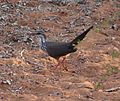- Madagascar spiny thickets
-
 Spiny forest at Ifaty, featuring various Adansonia (baobab) species, Alluaudia procera (Madagascar ocotillo) and other vegetation
Spiny forest at Ifaty, featuring various Adansonia (baobab) species, Alluaudia procera (Madagascar ocotillo) and other vegetation
The Madagascar spiny thickets (also known as the Madagascar spiny forests) is an ecoregion in Madagascar. The vegetation type is found on poor substrates with low, erratic winter rainfall. An estimated 14,000 to 17,000 square miles (44,000 km2) is covered with this habitat, all in the southwest of the country. The ecoregion contains an outstanding proportion of endemic plant species.
Contents
Plant diversity
 Approximate extent of the spiny thickets of Toliara Province, Madagascar.
Approximate extent of the spiny thickets of Toliara Province, Madagascar.
Many constituent plants show extreme adaptations to drought. Spiny plants of the endemic family Didiereaceae form a conspicuous component, especially towards the east. They are woody but distantly related to the Cacti (See Caryophyllales). The remaining component of the thickets is dominated by members of the Burseraceae, Euphorbiaceae, Anacardiaceae and Fabaceae families of plants, all which have representatives elsewhere.
Conservation
Existing reserves protect a maximum of 3% of remaining vegetation. The Andohahela National Park offers limited protection through its 'parcel 3' section. Elsewhere the spiny thicket habitat is under pressure from human exploitation. The main impacting activities are:
- Burning for conversion to grazing land
- Harvesting for charcoal and firewood
- Logging for construction[1]
Gallery
-
The Madagascar ocotillo, Alluaudia procera, named after the unrelated Ocotillo
-
The Bottle tree, Moringa drouhardii, found mainly in the spiny thickets
-
A Fat-tailed Dwarf Lemur of the spiny thickets and succulent woodlands
-
Verreaux's Sifaka, a lemur species occurring, in part, in the spiny thickets
-
A Ring-tailed Lemur in Berenty Reserve, set in the spiny thickets ecoregion
-
Grandidier's Mongoose, a range-restricted carnivore of the spiny thickets
-
The Subdesert Mesite, endemic to the spiny thickets
References and external links
- ^ Crowley, Helen. "Madagascar spiny thickets (AT1311), WWF Full report". http://www.worldwildlife.org/wildworld/profiles/terrestrial/at/at1311_full.html. Retrieved 4 February 2011.
- For extent, fragmentation and intact sections, see: A refined classification of the primary vegetation of Madagascar based on the underlying geology, Du Puy and Moat, 1996.
- For dominant plant families, see: Structure and floristic composition of the vegetation in the Réserve Naturelle Intégrale d’Andohahela, Madagascar, Rakotomalaza and Messmer, 1999.
- Madagascar spiny thickets (World Wildlife Fund)
- Madagascar spiny thickets (Encyclopedia of the Earth)
See also

This ecoregion article is a stub. You can help Wikipedia by expanding it.








